Tracking the impact of Australia’s horror bushfires
‘Apocalyptic is not too strong a word. Weeping is not too dramatic a reaction...’ In the burnt ruins of Australia’s east coast, Trent Dalton finds trauma, fury, shame and hope.
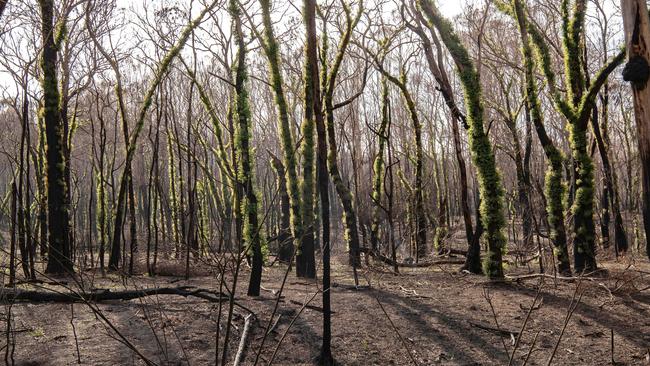
An old man and a dog walking into a burnt black forest. The man’s name is Maurice Manton and the Jack Russell’s name is Charlie. “Where I go, Charlie goes,” Maurice says, wandering between the black trees. He’s driving to the town of Moruya, south of Batemans Bay, to sell tubs of sandalwood cream at the Saturday morning markets but he’s stopped here at the side of the highway because he needs to make sense of what the fire did to the forest. The smell gets him first. The forest smells like a fireplace stuffed with five dead wallabies chewed out by maggots. Maurice wants to feel what the fire did because he couldn’t understand it from his living room armchair. This fire that swallowed up summer along with everything we thought we knew about land management. A fire of such terrifying ambition and adaptability; a thing so very good at doing all that it is here on Earth to do.
Black dust on Maurice’s hands. Burnt branches crumbling like meringue beneath his rubber thongs. He used to hear birds whistle in this place and the collective throb of insects but then the firestorm swept through Currowan State Forest and burnt all that good noise away, left no sweeter song behind than wind through leafless trees and the sound of highway dairy trucks hauling south towards the Victorian border.
But Maurice still pulls his car over to the forest edge for the same reason we all do. “It’s beautiful,” he gasps, head tilted back, awed by this black forest scene. And he doesn’t know if “beautiful” is the respectful thing to say but he can’t find a better way to describe new life when it emerges from certain death; wonder when it comes from destruction; light when it comes from dark. A gallery of towering eucalypts dipped in a tattooist’s thick ink, black upon black upon black, but from these hellfire poles shoot the most radiant splashes of new growth. They are a kind of green so vivid and glorious they make a mortal wonder what macabre trick Mother Nature was trying to pull for all of us slack-jawed southbound travellers, a handful of roadside strangers drawn to something beautiful born from something horrifying. Random weekend drivers dotted through the scrub, heads turned up to those bald black towers, trying to comprehend the incomprehensible.
If this scene has a feeling then it’s the one Maurice experienced when his wife Jenny died three-and-a-half years ago and he was left alone and his world was left black. But then, a year later, his daughter gave him Charlie the Jack Russell and Charlie brought the light back and Maurice came back from the black. And that’s exactly what the country’s doing, he says. “The country’s coming back.” Back from the black.
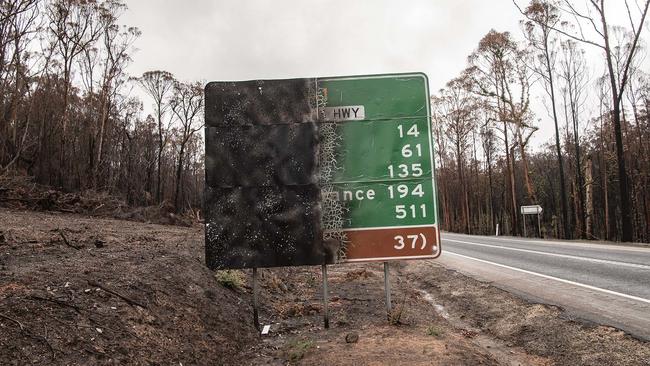
Litter across the forest floor. Beer bottles thrown from car windows, then melted by the fire. They bubbled and warped and then cooled into abstract art pieces that shatter with the slightest touch. Deeper in the forest, an amateur photographer crouches beneath a torched old black southern blue gum, long lens pointed up to a sky foregrounded by leafless black treetops that look like trident prongs pointing up to a blue roof that will soon turn to grey.
Two women further along the forest edge. Kris Nash and Brigitta Wimmer from the Australian Native Plants Society. They stand in silence, a kind of mute mourning, as though they are staring at an open coffin and someone they love rests inside. They know the silent miracles of this place. They know the fire’s power, too. Kris can only speak of her sorrow in disconnected words. “Depressing,” she says, shaking her head. “Unfathomable… speechless… tragic.” She can see thousands of native plants already shooting up from the forest floor. “Acacias,” she says, eyes scanning the forest floor. “Gahnia. Saw sedge. Lomandra. Wattle coming up from exploded seeds.” But she sees the future, too. “The amount of weed that will come through here now. They’ll come up quickly and take over the slower native plants.” But, then again, there’s something else she sees in those young and strong ferns climbing the sides of those black ink poles. “Hope,” she smiles.
A sign saying, “Please do not litter. Roadside penalty, $20”. More litter strewn across the forest beneath that sign. Potato chip packets, soft drink cans, cigarette packets, clothing; all burnt and black. Somehow a plastic digital pregnancy test survived the inferno by the side of the scorched road. And that’s the song of the south coast right now. How did that object possibly survive the fire? How did we possibly survive the fire? Then rays of blue sky sunlight shift through all the towers of black and the new ferns seem to wave for the light and there’s a dream quality here that speaks nothing of the truth of the nightmares found all the way down the NSW south coast.
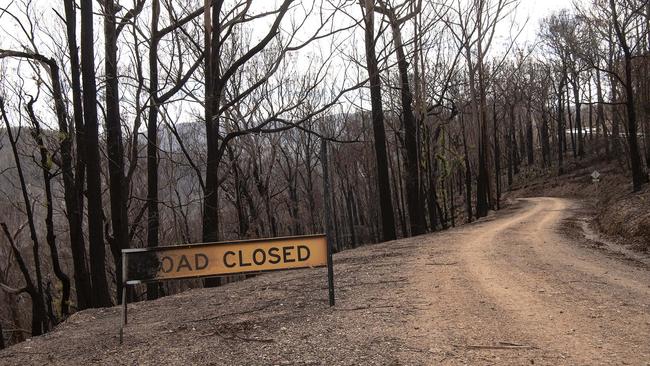
A simple enough drive. Batemans Bay, NSW, toMallacoota, in the East Gippsland region of Victoria. A summer drive down the Princes Highway that Australian holidaymakers have enjoyed for decades. But it’s never looked quite like this. Bald, scorched earth hills in the distance. Not trees lining those hills anymore, just black celery sticks with their heads hacked off. Black trees snapped in half by impossible heat. God shrugged His shoulders, stubbed out a Winfield Blue and tossed an ashtray full of burnt matchsticks across the hills of south coast NSW. Then God went to sleep for the summer. They’d all be weeping down here if weeping wasn’t such a waste of water.
A “Road Closed” sign, bent and burnt. Long stretches of verdant and lush green hills that the fire spared – whole towns left alone – and then longer stretches of winding road that twist deeper and deeper through the black. From afar these vast patches are easily mistaken for cloud shadow covering the land but it’s all grim firework.
Pull the car over and walk into Mogo village because it seems more respectful that way. A goldrush town turned to an arts and craft town turned to the town set alight on New Year’s Eve. Six local stores burnt to rubble. Dozens upon dozens of family homes burnt to ash and melted corrugated iron and glass. A chimney standing where a family cottage used to be. Burnt kitchen sinks where whole kitchens used to be. Toilet bowls and bathtubs where whole bathrooms used to be. Frames of children’s swing sets where backyards and birthday parties used to be. All that’s left are hard metal frames. Shells and carcasses. Signs and clues of ordinary lives lived in rural bliss. Netball hoops with no nets. Clay pots with no plants. Hills Hoists everywhere. The bloody clothes lines made it. Clotheslines and Buddha statues. No washing machines, no wardrobes, no underwear drawers, no pants. Just the clotheslines still standing where whole homes used to be. The plastic pegs on the lines now look like discarded globs of chewing gum. Garden pathways leading to nowhere. Staircases stepping up to nothing. Exploded barbecue gas tanks. Tin sheds melted down to the size of beer coolers. “Danger: Asbestos” signs everywhere. Heavy metal boat trailers covered in the metal of whole vessels that melted and dripped across their trailers and hardened upon cooling like liquid-metal Ice Magic.
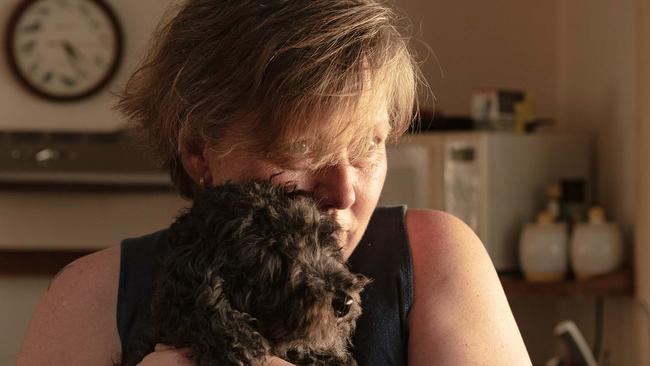
Here is a Mogo local named Rodney Yalg and here is his partner, Tracey Campbell, and this is what they call “survivor’s guilt”, the feeling of standing on their front porch and looking around at four blocks of land surrounding them where the fire burnt their neighbours’ homes to the ground but spared their own. An inexplicable game of natural-disaster roulette.
“Why did our house survive and nobody else’s did?” Tracey asks herself. That picky bastard fire. That fickle bitch. The man across the road had a glorious two-storey red cedar home with a chimney and he was a good man who deserved to live the rest of his life in the home he loved. Now all that stands of that home is the chimney. Noreen, the neighbour on their right side, is about as good as a person can get, kind and warm and decent. And Tracey feels she hasn’t always been as good as Noreen has but it’s Noreen’s home that’s now a collection of scrap brick and metal. “Why spare our place?” Tracey asks and that impossible question echoes down the south coast.
That fire woke Tracey up. “I woke up to the smell of smoke and walked out to the front and everything was orange,” she says. Tracey and Rodney packed their car and left their home to fate and stepped on the accelerator in a direction terrifyingly unclear to them. “You don’t know where that fire is,” Tracey says. “All you see is the orange glow and you don’t know if it’s 100 metres down the road or a kilometre. You don’t know if you’re gonna make it out before it hits.” The orange sky turned to red and then to black. The heat in the air was unbearable. They were certain the fire had surrounded them.
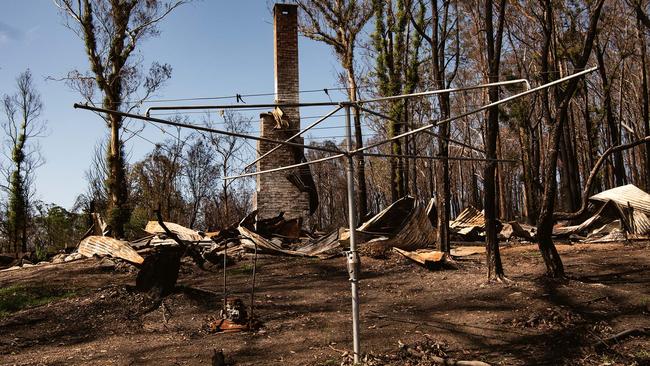
Rodney’s father died three days before the firestruck Mogo. He was sorting funeral arrangements when the fire came. A year ago, Tracey’s daughter was diagnosed with cancer. A year and a half ago her own father died. “Yeah, it’s been a shitty two years,” she says. “We lived through this. We came back to find the house was intact. Then my head snapped. I couldn’t cope.” She was a manager in an aged care facility. “I went back to work for four days and then I quit my job.” She shakes her head. “Nup. The anxiety. Couldn’t do it. Couldn’t concentrate. Couldn’t cope.” Tracey says there’s an online Batemans Bay community noticeboard filled with the posts of locals struggling with mental health issues left behind by the New Year’s Eve fire.
“There are so many who are struggling. The trauma is huge. Regardless of whether you lost your house or you didn’t, it’s there and it’s only getting worse. You wake up every morning and you go out and you see all this rubble around you and you just go, ‘I don’t get it. I don’t understand. I don’t understand why we’re still here.’ I’m anxious all the time. I wake up every morning thinking it’s coming back. For weeks on end the fires weren’t out and you were constantly getting told to be alert and ready to get out. I had my bags packed for a month. It’s so hard to describe, not knowing what’s going to happen.”
No more trust. Can’t trust the land. Can’t trust the writing at the bottom of every state forest sign: Your forests are in safe hands. Can’t trust government bureaucracy. Can’t trust fire. Rodney calls it “hypervigilance”, the permanent knife-edge they’ve been balancing on; the mental toll of it. “It comes in waves,” he says. “I’ll be sitting there and suddenly I’m feeling really down and then I’m seeing that more and more in the community.” So Rodney and Tracey are getting out. They’ve made some plans. “We’re selling up and we’re gonna travel,” Tracey says. “If we’ve learnt anything it’s that it’s too fricking late to wish you could have done things when disaster comes. I’m not just going to work and work and work and not see anything in my life. So I’m going to work around Australia and spend a couple of months in each place.”
She looks at Noreen’s block of rubble, shakes her head. “That fire woke me up,” she says. “You see this big wave of orange coming towards you and you go, ‘F..k, I don’t want to die. I don’t want to die. I’m too young to die. I’ve got so much to do.’ Life is too damn precious.”
Not long after the fire swept through Mogo, Tracey found herself phoning long-lost friends and relatives. “I just started apologising to people for anything I’d done when I was younger,” she says, weeping as she speaks. “I got in contact with family I hadn’t spoken to for a while and I apologised for my bad deeds. I evaluated everything. That’s what that fire did to me.”
Rodney nods. “You know the Five Stages of Grief and Loss?” he asks. “This town is going through all those stages. At the moment we’re moving into blame. Who done this, who done that? That plays out with every person eventually in some form.” It’s playing out in Tracey this afternoon. “Too many people put too many expectations on the government to get everything right and be perfect,” Rodney says. “Are they ever gonna get it right when it comes to a natural disaster?”
“I disagree,” Tracey says. “Where was the firefighting equipment the community asked for years ago? And Scott Morrison being in Hawaii? We don’t give a shit about what he says and what he does or if he can fix it or not. We just want to know the man we voted in is here and representing us. And he wasn’t here. That’s it.”
Rodney takes a deep breath, dwells on this thought, changes the subject. “Have you got a name for your story?” he asks. No name yet for the story of the inferno that left 2500 homes in ruins and 33 bereaved families in tears. “What do you think the story should be called?”
Rodney shrugs. “It goes deep into human nature this all does,” he says. “It’s a story of people backing each other up,” Tracey says. “People getting out and helping one another. The bloke at the IGA who opened his shop on a generator. Took so many ‘IOU’ orders. He just fed the lot of us.”
“You lose everything,” Rodney says. “You lose power. You lose your house. You lose hope but then you find all these other things in human nature.” Tears in Rodney’s eyes now and he wipes them with a forefinger and thumb. “It’s a survival story in the end,” he says.
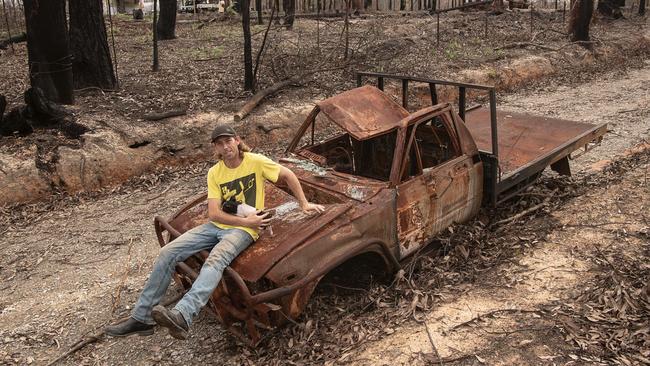
On the other side of town, a tattooed man named Brian mows his lawn in a pocket of Mogo surrounded by scorched and desolate bushland. “I was stuck in Canberra when the fire came through,” he says. “I found out the backyard was on fire. The shed. The fence. The house was gonna go.” Brian points to the house next door, a rambling home surrounded by burnt-out cars and buses and collected ephemera on the edge of a black Mogo forest. “He saved it all,” Brian says and he can say no more because he’s going to break down in tears if he keeps talking.
Wazza Shaw is a big-hearted, mullet-wearing 39-year-old father of two who speaks like someone who just stepped out of a western Queensland shearing shed in 1935. “Surprised Brian even told you that,” he says. “We haven’t always gotten on that well. Reckon we’ll get on fine now, ’ey?”
Wazza nods his head. “Yeah, I stayed and fought for my house and then I looked down the road and saw his house on fire and so I stayed and fought for his house, too. Then I looked across the road and I saw another house on fire and they weren’t home, too, so I saved that one as well. That’s what you do. That’s just being human isn’t it?”
He knew the fire was coming. He chopped down the trees surrounding his house. He wet down the yard. He cleared the piles of leaves in front of his house. He was worried about the stacks of wood palings he keeps under his house. Spot fire and ember attack. So many houses lost on the south coast were set alight by spot fires giving flame to combustibles beneath homes and by embers that soared through the sky 15km ahead of the firefront and landed on dry leaves scattered around yards.
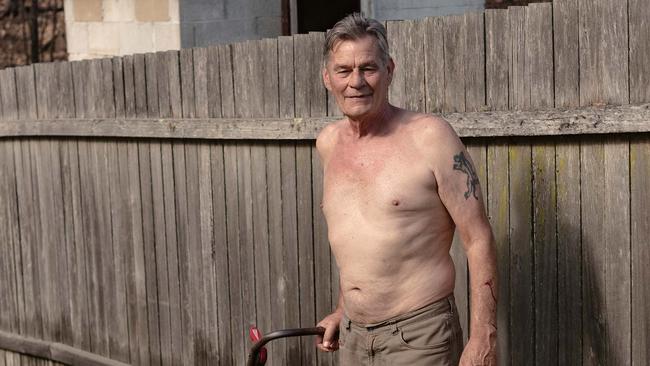
Weeks before the Mogo fire, Wazza helped his mum fight a fire that consumed their family home in the Currowan area, north of Batemans Bay. He learnt things from that experience. The type of equipment he would need to save his own home. He fashioned a fire hose from a generator pump and a large water container that he connected to the back of his ute. “Tuesday, 31st December, I wake up at 4am because the missus has gone to the toilet,” he says, walking on to his front porch, which looks out to a horizon of eucalypt hills. “I jumped up and came out here and that whole horizon up there was glowing orange. And you could hear it. It sounded like a freight train. Woomp. Woomp. Woomp. This thing didn’t stop. Louder and louder and louder until that train pulled into the station. Get the kids up. Pack the car. Missus and the kids are outta here to the beach for safety.”
Plan A: wet the house down until the fire sweeps out of Mogo. Plan B: open the iron grate in the gutter on the street and slide into the stormwater drain and pray a bloke don’t suffocate. “Thank f..k I never had to go to Plan B.”
A survival story in the end. Wazza pads across his yard looking at what survived. Four out of 10 pigs in a backyard pen. A random pot plant. Not much else. Car bodies, garden tables, work benches and tools burned to liquid metal. Mogo was pitch black at 11am, New Year’s Eve, and Wazza Shaw was alone and deeply lonely, one wiry man with a makeshift fire hose standing before a firefront that looked to him like hell had sprung a leak and the devil blew all of its deep red fire toward Mogo.
“Everyone had bailed,” Wazza says. “I was the only one in the street. My shed was on fire, my cars, my bus where guests sleep over. At the last minute I used all my water to save the house. I would have nothing if I lost the house. In the end, there was nowhere for me to go. I’d gone past the point of no return. I couldn’t get out of the street and I knew that. Why did I risk my life? I don’t really know the answer. I can’t say I have faith in the home insurance system when there’s something on the scale of this. If they don’t pay out I’ve got nuthin’ but dirt that the bank owns. I think I did the right thing for us. My wife still loves me and I’ve still got a home for my beautiful family.” He shakes his head, shrugs his shoulders. “I’m Wazza,” he says. “I was Wazza and I still am.”
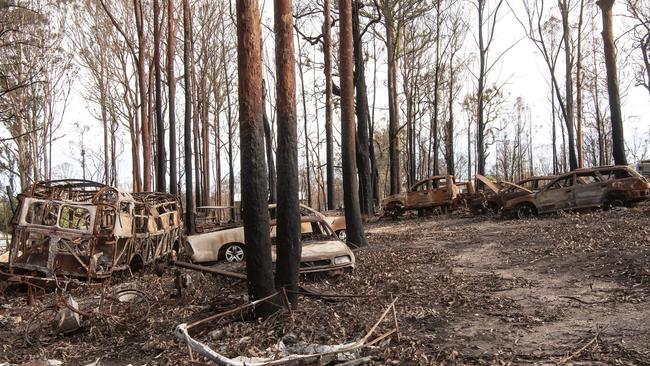
Back on the Princes Highway and you’re noting all the questions they said they ask themselves with their heads on their pillows at night. How am I gonna move all that scrap metal? Should I just move myself away from all that scrap instead? Did I pack the home insurance forms before we got out? Should I have stayed or was I right to leave?
Here’s a rare kind of shame one anonymous man must live with for the rest of his life. His home was surrounded by forest and he vowed to stay and fight the fire, and his teenage sons vowed to stay with him. The part of being a father who takes pride in the bravery of his sons, in those wild fire hours, temporarily overwhelmed the part of being a father that told him he must protect his sons at all costs, even if those costs included the home of his dreams. They fought that fire together but there was a moment under that black daytime sky when the father realised the fire had wedged him and his beloved sons in past the point of no return. The point of no escape. And the father felt shame in that moment before he felt fear. If that fire broke their feeble hose-wetted border around their house and swallowed his boys up then he knew his last horrid thought would be that he was responsible for the death of his sons, his very reason for being.
That’s why they have names for the fire. They call it the beast. They call it the monster. The monster grew bigger and the monster grew smarter. It got inside their minds like it got inside their hallways. The monster exposed everything: the flaws in best-laid plans, in old ways of thinking. It exposed the flaws in pride and material possessions. The monster had fires for fingernails and they dug down deep inside people’s crowded heads and broken hearts and exposed their fears like it exposed their bedrooms, left them gutted and covered in ash under the summer sun and the summer rains that always come too late.
Night falls across Cobargo in the Bega Valley Shire and the Cobargo Hotel Motel bistro fills with locals and Army and emergency services workers shouting each other schooners. Anyone whose house burnt down in the New Year’s Eve fire doesn’t have to buy a beer and that feels like half the people at the bar. “Ticket 2353,” says the man by the TV screen announcing the numbers for 20 fundraising meat trays being handed out tonight.
This is the town that chased Scott Morrison back to Canberra when he arrived in the makeshift emergency relief headquarters set up in the local showgrounds. He turned up well-rested from his Hawaiian holiday and, with all the bedside manner of a hibernated bear, threw his open right hand at anyone kind enough to take it. Best intentions, worst outcomes. He was caught on camera forcibly shaking the hand of a visibly distraught local woman. “I’m only shaking your hand if you give more funding to our RFS [Rural Fire Service],” the woman said. “So many people have lost their homes.” Then some locals told him how they really felt. “You’re an idiot.” “You’re not welcome.” “Every single time this area gets a flood or a fire we get nothing.” “If we lived in Sydney or on the north coast we would be flooded with donations and emergency relief.”
The bar staff here have been taking calls for weeks from people across Australia and the world who pass their bank details over the line with strict instructions that the now-celebrated local firefighter caught on camera refusing to shake his Prime Minister’s hand must never have to buy a beer in Cobargo again. Here’s a woman wearing a “I Survived the ScoMo Fires and All I Got Was a Handshake” T-shirt. They didn’t know what to name the fires so they named them after their Prime Minister. There’s a man wearing a “Cobargo As F..k” T-shirt. Both shirts are on sale in Cobargo and online to raise money for the community and both shirts speak of the unbreakable solidarity and resilience of the town.
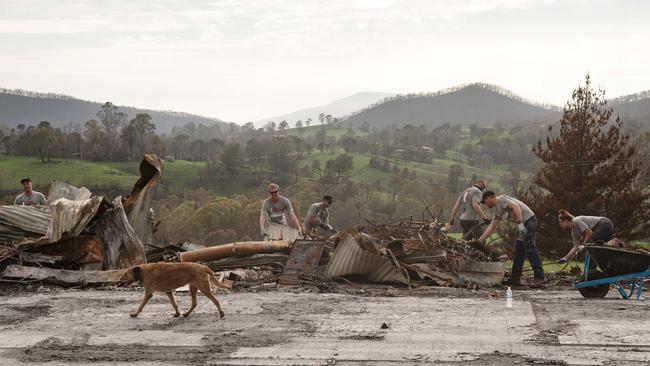
Here’s a group of men with the words “Team Rubicon” emblazoned across their shirts. Maybe 20 of them in total. Big lads. Strong and useful in a jam. Team Rubicon is a global movement of volunteers – often military veterans and first responders with their own experiences of trauma – who deploy to the world’s disaster zones at a moment’s notice. They’ve flown here from across Australia and New Zealand and a small group has flown all the way from Norway. They smoke cigarettes and make toasts in a circle, celebrating the end of an eight-week deployment in Cobargo where they’ve been moving from block to block dragging melted scrap metal and waste from properties before the usually wet eyes of stunned and grateful homeowners who have lost everything. A bearded former soldier from Brisbane named Vaz pads over to an outdoor table where a local fisherman named Tom “Swampie” Wotton is having a smoke and a beer with his son-in-law. Swampie stands and hugs Vaz and the two men wipe tears from their eyes like they’ve both survived a war, which in some ways they have.
Swampie’s home in an isolated pocket far along Wandella Road was burnt to the ground and a lifetime of valuables was burnt with it. He’s crying now because he can’t find the words to thank Vaz and his fellow volunteers who simply arrived at his gate one day like a bunch of tattooed and bearded fallen angels and, without instruction, began systematically clearing Swampie’s property. Swampie’s head falls into Vaz’s shoulder. “I know, mate,” Vaz says, patting Swampie’s back. “All good. All good.”
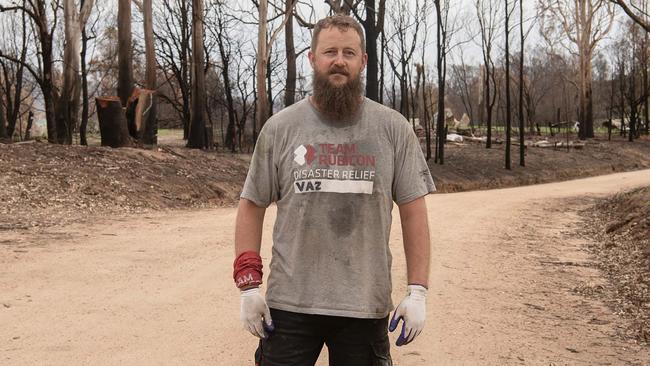
Vaz spent 10 years in the army before, he says, “I got injured pretty horrifically”. “I’ve suffered depression, PTSD, couple of attempts at suicide,” he says. “I tell you what, mate, meeting Swampie here has been the highlight of my week. I know a bit about what he’s going through. I can’t imagine coming home and seeing what he had to see. I just had to come here and do what I could. The hardest part for us is that we’re leavin’. We need to go home but we know there’s so much more to do.”
“You’ve done enough, mate,” Swampie says, his arm on Vaz’s shoulder.
“Everybody here is grieving,” Vaz says. “And then they’re gonna go through that angry period but after that they have to sit back and go, ‘All right, where do I start to fix this?’ That first step. That’s going to be the hardest step for every last person. But it can be fixed. We can rebuild. And you’re not alone in the rebuild. Pardon the French, but people really do give a f..k.”
The next morning at the Cobargo showgrounds, disaster co-ordinator Chris Walters is working the phones in the office of the Cobargo Bushfire Relief Centre. She’s been here six days a week since January 5. Her office is next door to a shed where newly homeless locals living on the showground fields in emergency caravan accommodation fill shopping bags with donated supplies: canned goods, breakfast cereals, soaps, clothing, sleeping bags, medical supplies, baby food, pet food. There’s a tool bank for people whose tools burnt in the fire.
“I’d like to think we’re in recovery mode but recovery is the wrong word,” she says. “You’re never gonna recover from this. Recovery indicates you’re gonna go back to where you were before. We never will. This is a new life coming on. Some people are still really, really stuck in their grief. We’re still getting people coming in, seven weeks later, who have never been in before. It’s the first time they’ve been ready and able to come into town and ask for help. They just haven’t been able to do it.”
In a shelter by the showgrounds’ freshwater depot – some drinking water stocks along the coast have been contaminated by ash – a young Army officer checks an exercise pad in which she has listed numbers for the countless locals whose properties her emergency response unit has assisted. She warns us to be careful around some locals. “They’re pretty angry out there,” she says. “Some of these blokes will pull a shotgun on you.”
On the edge of town, a soft-spoken and gentle man named Malcolm Elmslie pads warily to the edge of a rubble collection that once was his century-old Cobargo homestead. “I know what I’ve lost,” he says, and he leaves a long, haunting space of dead air between his next word. “Everything.” Books. Rare albums. A grand piano. A whole life hidden somewhere in the rubble. Some brick walls remain, on the verge of collapsing. “Don’t get too close,” he warns.
Malcolm helps run the Cobargo RSL. He woke at 2.30am on New Year’s Eve to see the terrifying firefront charging down from the hills surrounding his home. There was a long period during his frantic escape from the house when he couldn’t find his dog, Bonnie. He searched his property even as it was about to be engulfed by flames. “Bonnie!” he hollered. “Bonnie!” And then the dog emerged and he’d never been so grateful to see a living thing walking toward him.
By then there was little he could do to save the homestead. Fire all around him. No sign nor sound of fire trucks. Only disintegration. He simply found a patch of grass on a sloping field and sat in the darkness with his arm around Bonnie and watched their home slowly turn to ash. In Malcolm’s shorts pocket is a small spiral notepad and pen. It was the first thing he asked for at the disaster relief centre. Then he sat down by himself and flipped open the notepad and began writing a strange reverse inventory of all he had lost. And when he finished that list he began to write a list of all the things he needed to do to rebuild his life. “I was told I was in shock,” he says. “But I was just starting again.”
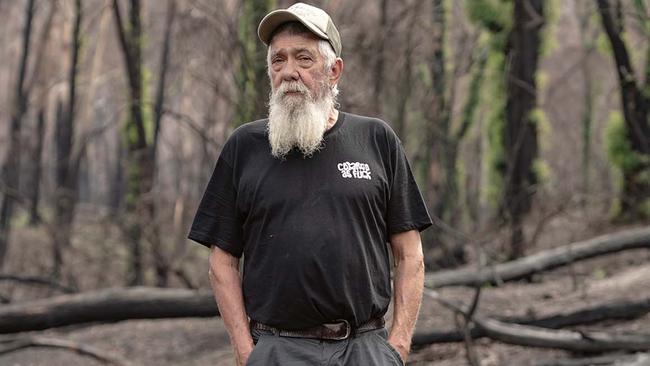
Tom “Swampie” Wotton’s having breakfast this morning alone in a small caravan parked in front of his daughter and son-in-law’s house on Bank Street, not far from the Cobargo pub. He takes a morning drive around his town. He shows you the signs marked “Blaze Aid” where a small tent and caravan village has spread across the town’s sports ground, filled with emergency service workers and volunteers. He shows you where the firewall sent its ember armies out ahead to slip under homes and businesses in town to burn them out from beneath.
We drive deep into the Cobargo hills where the trees are black and lifeless, and find a section of road where every house along it was consumed by fire. “The pumps stopped out here for the firefighters because the smoke was so dense that there was no oxygen getting to the water pumps,” he says. The stretch of road makes Swampie shudder. “F..k this shit,” he whispers.
We pass the property where dairy farmer Patrick Salway, 29, and his father Robert, 63, died trying to save the family home. Patrick’s wife, Renee, was the very definition of grace the following day; light from the dark. “I love you now, I love you still,” she said. “I will see you again, Patrick, my best friend. Hope you are up there fixing things in the stars tonight.”
Swampie’s moved from grief to anger in the space of a car trip. “Thing came across my paddock like a big angry fireball,” he says. “Sounded like a f..kin’ jumbo jet taking off.” Think of the sound of one eucalypt crackling and exploding in the kind of fire heat that sees car windscreens melt and drip onto steering wheels like pouring cream. Now multiply that sound by 20,000 eucalypts. “Scares the livin’ shit outta ya,” Swampie says.
We pass the local dance hall, burnt to rubble. Swampie looks at the bald and black hills surrounding his home. He owns 110 acres here and every one of them is burnt. “This used to look like Jurassic Park,” he says. We drive into Swampie’s property where he sifts through what he calls “the survivors” and he doesn’t mean humans. He’s talking about usable knives and forks, enamel cups. A hip flask he hasn’t seen for 15 years. There are things he’s been trying to find for decades that the fire helped him find. The fire exposed them, blew them into clear sight. Metal keepsakes. Every burnt object has a story. Swampie’s wife’s 50th birthday party. Riotous rock’n’roll parties for his daughter. Sweeping Christmas feasts at the dining table that has disappeared into dust. Scrap and waste that Team Rubicon has sorted into piles along the edges of cleared concrete slabs where once his five-bedroom home stood.
He keeps seeing things we can’t. “Here’s the pantry,” he says, staring at air. “Here’s my bedroom.” He stands in the middle of the rubble and he lights a cigarette and takes a long, pained drag. He fiddles with a handle on the only thing he thinks he can make work again: a freestanding combustion fireplace. That’s the only real survivor left. A thing to make more fire. “Home sweet home,” he says.
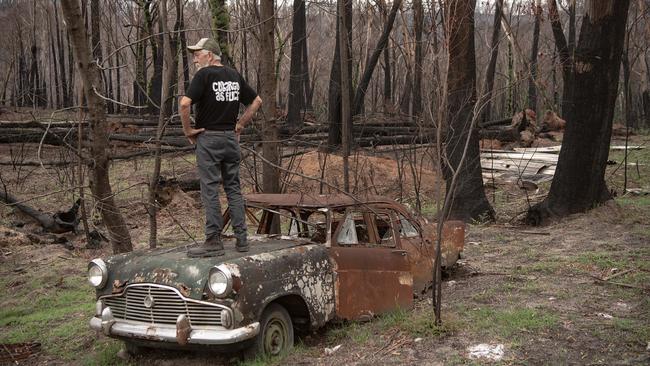
The Princes Highway rolls on and the broken fire belt rolls on with it. The town of Bega, where hundreds of emergency service workers and local firefighting volunteers are still reeling from a knee-buckling fight with a burning bully that bashed them relentlessly, week after week after week. Weary volunteers only just returning home to the towns of Tathra and Wyndham and Pambula and Merimbula. If there’s a hell on earth today then it is a 10-minute drive south of Eden in the vast, endless burnt-out hectares of East Boyd State Forest. Apocalyptic is not too strong a word. Weeping is not too dramatic a reaction. Utter desolation.
In most stretches of the burning along the south coast there is green life regenerating in the undergrowth. Here there is only dirt. And from this useless dirt rise spears of snapped trees that look like spikes now, the kind an ancient barbarian horde might use to display the bodies of their vanquished. A Dante kind of hell. A Bosch kind of hell. The whole twisted black place is a funeral song that never ends, echoing as far as the eye can see.
Deep in the hills beyond Upper Kiah Road, 39-year-old mother of six Theresa McGovern unloads her twin baby boys Artie and Alby from a four-wheel-drive into a pram. The pram’s wheels don’t roll properly but this one will have to do because the boys’ regular pram was burnt in a blaze that Theresa’s husband, Andrew, and her father, Errol, valiantly fought for three hours with makeshift fire hoses and the best of their shared common sense. The boys saved Theresa and Andrew’s home but Errol’s sprawling family home next door burnt to ashes. Theresa’s here to assess the damage, collect some things that survived the fire. She stands on a hill and looks down at her parents’ house; all that iron and glass and black wood buried in the dirt.
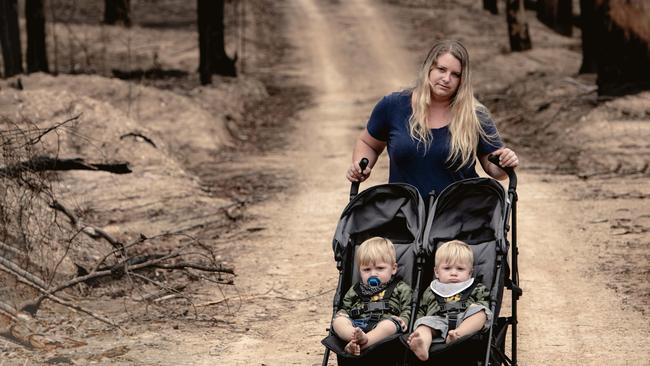
“There used to be a beautiful big deck on that place that we used for weddings and special family events,” Theresa says. “Seven-bedroom home. Gone.” She raises her eyebrows. Shrugs her shoulders. “Pot luck,” she says, tears forming in her eyes. Theresa grew up in this vast bush valley. “Nearly all the family homes we’ve all grown up in at one time or another burnt down in this fire,” she says. “That’s probably seven or eight homes we’ve lived in over the years. All burnt down. That’s how wide this fire went. Devastation everywhere.” Theresa can’t think of that awful fire sweep for too long because the frustration of it always turns her into the kind of person she doesn’t want to be.
“My dad’s been the captain of the local fire brigade all my life,” she says. “His father was the fire captain before him. I grew up burning off every winter on the property with Dad. He’d give me a box of matches and show me how to light a hill and how to manage it responsibly. Dad’s always said a lot about how they’ve locked a lot of areas up now and they don’t let you do the same sort of fire management techniques they did years ago. They fought fires really well back then. They didn’t let them burn for months. They went in and they put it out and then they came home. They didn’t have to wait for permission from three levels up to look after their land.”
Theresa looks up to the sky to follow the sound of a bird squawking at something in the forest of broken black trees. “Haven’t heard that sound for weeks,” she says. “Nice to hear that sound.”
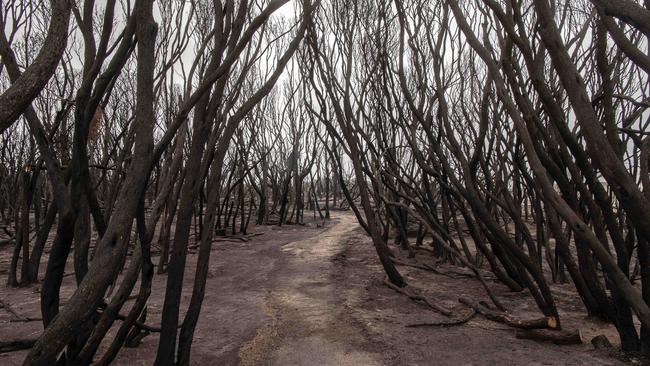
Further south along the highway is where New South Walesand Victoria meet with their respective welcome signs facing each other, both signs singed and melted by the firestorm. On the back of the NSW sign someone has spray-painted the words SAD BUT NORMAL. The words seem to fit the ash-covered setting. This is sad but this is the new normal. This is sad but we better get used to it.
“I’d seen something like this before,” says Max Donovan, manager of the A’Wangralea Caravan Park in seaside Mallacoota, on the coast across the Victorian border. “In ’82-’83 in Orbost [120km west of Mallacoota] I was stuck in a firefront there. I knew a bit about what was happening.” Well before the New Year’s Eve firefront reached his town, Max advised his park guests to evacuate Mallacoota immediately. “People couldn’t get it in their head when I said to them it was going to go totally pitch black dark at 10am in the morning,” he says. “They laughed, ‘Awww, righto mate!’ Soon I couldn’t see one metre in front of me.”
Even after the local Country Fire Authority held a meeting in town alerting tourists to what was coming, some holidaymakers in Mallacoota were still seen relaxing over glasses of wine and plates of cheese. Soon red embers were raining across town. Max strapped on a headtorch and, with four close friends and his 25-year-old son and wife, attempted to save his caravan park.
“When it was coming at us it was making its own weather pattern and it felt like thunder and lightning but the sky was red,” Max says. “The smoke plume was 14km in the air and you watched it just rolling toward you, like rolling thunder, and then came the roar of it. The boys that were with me said, ‘Jeez, the seas are sounding rough’. And I said, ‘No, mate, that’s not the sea. That’s the firefront’. Then suddenly we saw houses falling down and the gas bottles exploding inside them and the trees toppling over.” His lips tremble when he talks about it. He shakes his head with the strange intensity of it all. “But we stayed,” he says. “We stayed and we saved.”
On the Mallacoota foreshore today, locals are returning to the beach where only weeks ago some 4000 evacuated and stranded residents and tourists stood under that crimson and terrifying sky as the fire swept through town and Australian Navy vessels began rescuing evacuees in what local MP Darren Chester called an “unprecedented mass relocation of civilians”. Images from that desperate evacuation spread across the world and the tourist town of Mallacoota and the heartbreaking Australian bushfire crisis of summer 2020 were talked about at water coolers from New York to London to Brazil.
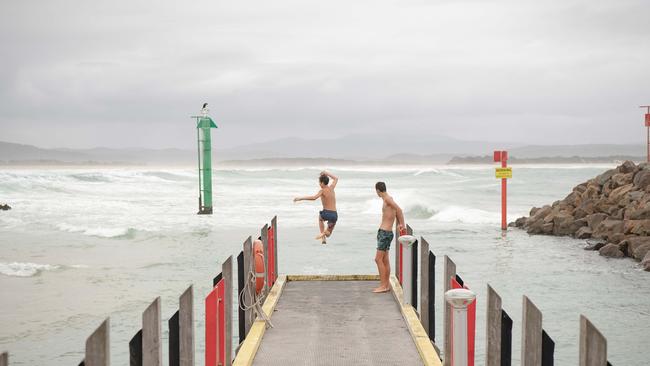
If there’s a right place to end this journey thenit seems right to end it here at Mallacoota’s glorious Bastion Point, at the edge of the ocean where the access steps down to the beach were stolen by the fire. Max Donovan and his fellow members of the local Lions club rebuilt those steps in four long and remarkable days recently because they knew that access to the beach meant normality returning to Mallacoota.
“Normality is Bastion Point beach,” Max says. “We all sat around and we had a few beers and we said we needed to get people back on that beach. We rallied around and we got about 20 blokes together and we just all worked together and we got them steps up and running in four days.”
And now the people are coming back. Back from the black. It’s a story of survival in the end. Towns. Communities. Families. Homes. Hope.
Here’s a girl named Airly Embleton-Mew walking her dog Sinbad across the soft sand beach. Airly evacuated to the town hall during the fire. Her grandparents are living with her now because they lost their house, had to be airlifted out.
Here’s a local man named Jeff staring out to sea. His house in town burnt down. He and his partner evacuated in his tinny with nothing but their dog and two shopping bags full of clothes. “We just laid in that boat for seven hours, wondering what was coming next,” he says. “But I’m still here and I’m stayin’ here. I’m looking forwards, not backwards. That’s the only way to look.”
Here’s a mother-of-two named Vicki Brown. She’s watching her two teenage sons, shirtless and soaked by saltwater, exploring the jagged rocks by the Bastion Point jetty. Vicki and her family have travelled north here from far out of town today. They have returned to collect a camping trailer and other items left behind when they evacuated their Mallacoota campsite in the New Year’s fires. “You know what,” she says. “We were anxious about coming back here. But now that we’ve come back and we’ve come down here and we’ve seen this beautiful beach again, it feels quite…” – she thinks of the right word – “… healing.”
She turns again to her boys who are now padding across the pier where not so long ago frantic families were piling into navy transports. The boys stop and adopt the stances of two Olympic sprinters at a start line. They nod to each other. Ready. Set. Go. And two shirtless and sun-browned Australian tearaways sprint to the end of the Mallacoota jetty and the boys are already laughing when they leap so high for the sky that they might just choose to stay up there in that clear air and not come down until the end of summer.



